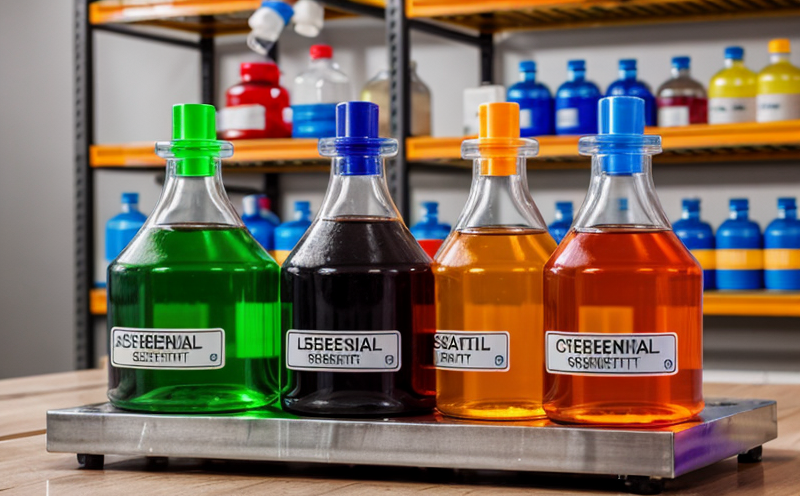MIT (Methylisothiazolinone) Testing in Consumer Products
The presence of Methylisothiazolinone (MIT), a widely used biocide and preservative, is critical to the formulation and safety of consumer products. MIT plays a crucial role in preventing microbial growth in cosmetics, household cleaners, and personal care items. However, its usage must comply with strict regulations due to potential health risks, especially for sensitive individuals.
Our laboratory specializes in providing comprehensive MIT testing services aimed at ensuring compliance with international standards such as ISO 21795-3:2018, which governs the determination of preservatives and biocides in cosmetic products. This service not only ensures product safety but also helps maintain brand reputation by avoiding recalls or legal issues.
The testing process involves several key steps. Initially, samples are collected from various stages of manufacturing to ensure accurate results. Specimen preparation includes thorough extraction techniques tailored for different matrices like liquid soaps or lotions. Our state-of-the-art laboratories employ advanced analytical methods such as High-Performance Liquid Chromatography (HPLC) with UV detection to quantify MIT concentrations accurately.
Acceptance criteria for MIT testing are stringent and vary depending on the product type and jurisdiction. For instance, in the United States, the Food and Drug Administration (FDA) sets limits based on the final concentration of MIT in the formula. In Europe, regulations under REACH may impose different thresholds or additional restrictions.
Understanding these regulatory requirements is paramount for manufacturers to avoid non-compliance issues. Our experienced team works closely with clients throughout the testing process, offering guidance on formulation adjustments and compliance strategies. By leveraging our expertise, businesses can ensure their products meet rigorous standards while maintaining quality and safety.
Why It Matters
The importance of MIT testing extends beyond mere regulatory adherence—it directly impacts public health and consumer trust. MIT is used extensively in personal care items due to its effectiveness against microorganisms, but it can also pose risks if not properly managed. Exposure to high levels has been linked to allergic reactions and skin irritation.
Consumer demand for safer products drives the need for stringent testing practices. By ensuring compliance with international standards like ISO 21795-3:2018, manufacturers demonstrate their commitment to quality and safety. This not only protects consumers but also enhances brand reputation and market competitiveness.
Regulatory bodies around the world are continually updating guidelines to balance the benefits of preservatives against potential risks. Our laboratory remains at the forefront of these developments, providing up-to-date testing capabilities that align with evolving standards. Through our services, we help clients navigate this complex landscape confidently.
Customer Impact and Satisfaction
The implementation of robust MIT testing protocols has significant benefits for both manufacturers and end-users. For businesses, compliance ensures legal safety and protects against potential financial losses from recalls or litigation. It also supports the development of innovative formulations while adhering to strict regulations.
For consumers, safe products build trust and loyalty towards brands that prioritize quality assurance. In an era where transparency is key, MIT testing demonstrates a company’s dedication to maintaining high standards in product safety.
We pride ourselves on delivering exceptional customer service by offering personalized support throughout the testing process. Our team works closely with clients to understand their specific needs and challenges, ensuring tailored solutions that meet both regulatory requirements and business objectives. This collaborative approach fosters long-term partnerships built on mutual trust and satisfaction.
Use Cases and Application Examples
| Product Type | MIT Concentration Limits (mg/kg) | Regulatory Compliance |
|---|---|---|
| Cosmetics | <100 ppm | ISO 21795-3:2018 |
| Household Cleaners | <100 ppm | REACH, EU regulations |
| Paper Products (e.g., diapers) | <50 ppm | ASTM D6832-96(2014) |
Methylisothiazolinone is commonly found in a variety of consumer products, including cosmetics, household cleaners, and paper products. Each product type has specific MIT concentration limits set by relevant regulatory bodies to ensure safety.
For instance, in the case of diapers, which come into direct contact with sensitive skin, MIT concentrations are strictly limited to prevent irritation or allergic reactions. Our laboratory provides detailed reports outlining the exact levels detected, helping manufacturers adjust formulations as needed.





